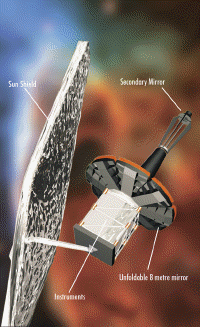The Technology
There is no doubt that building the Next Generation Space Telescope (NGST) will be a considerable technological challenge.
 Infrared astronomy needs cold instruments
Infrared astronomy needs cold instruments
The expansion of the Universe means that the further back astronomers look in time, the more light gets shifted to longer wavelengths. Longer wavelengths mean redder light, and ultimately the light from the most remote objects in the Universe will be in the infrared when it is received.
Observing infrared light is not easy - all objects in the Universe emit infrared light, also known as heat radiation - even telescopes. Optical telescopes are put in dark places for the best results and infrared ones need to be kept as cold as possible in order not to confuse the observations with infrared radiation from instruments and telescope structures. In NGST the instruments will have to be cooled to -240°C. How will it be possible to cool very advanced electronic and mechanical parts to a temperature where metal is as brittle as glass? Let alone make every component work under these extreme conditions for five to ten years?
Figure 1. NGST - Artist impression
 Far away
Far away
NGST will be placed 1.5 million km away from the disturbing radiation of the Earth at the so-called L2 point. L2 is a nearly stable point in the direction opposite the Sun where the system of forces from the Sun and the Earth keeps an object rotating around the Sun in synchronisation with the Earth. However this remote location also puts very strict constraints on the specifications of NGST and in particular on its weight and the communication systems.
 Bigger is better
Bigger is better
The collecting area of NGST is one of its most important advantages. Even though Hubble only has 1/17 the collecting area of today's largest ground-based telescopes, its images are much sharper and fainter objects can be detected than is possible from the ground. One can only imagine what a telescope with ten times the collecting power of Hubble will be able to do scientifically.
One of the major technological challenges will be to pack an eight metre telescope into a small rocket with a diameter of 5-6 metres. The only way to solve the problem is to divide the mirror into several parts and to fold it up like the petals of a flower during launch. When the mirror is unfolded on the way to L2, ultra-precise mechanisms will adjust the position of each petal with extreme accuracy. Some of the scientists working on the construction of NGST have described it as "a bit like designing a ship in a bottle".
 Technological challenges
Technological challenges
Folding up a large, very accurate eight metre mirror, fitting it into a rocket with a diameter of 5-6 metres, and unfolding and adjusting the mirror petals to high accuracy after launch.
Cooling instruments and mechanisms to -240°C and making them work at such extreme temperatures. It will also be a challenge to prevent the electronics from radiating heat and thus heating up the instrument bay.
Constructing the large telescope, the very large sunshade (the size of a tennis court), and the large instruments with a total weight of less than 3 300 kg (less than 1/3 of Hubble's weight). The mirror will have to have a surface density similar to that of a coin so as not to be too heavy.
Designing and manufacturing the new very sensitive instruments and detectors.
NGST has to be extremely reliable and stable, despite utilising new and innovative technology. In the L2 orbit approximately 1.5 million kilometres from Earth it is not possible for astronauts to perform service missions as has been done with Hubble.
Constructing, launching and operating NGST at a cost significantly below that of its predecessors.

